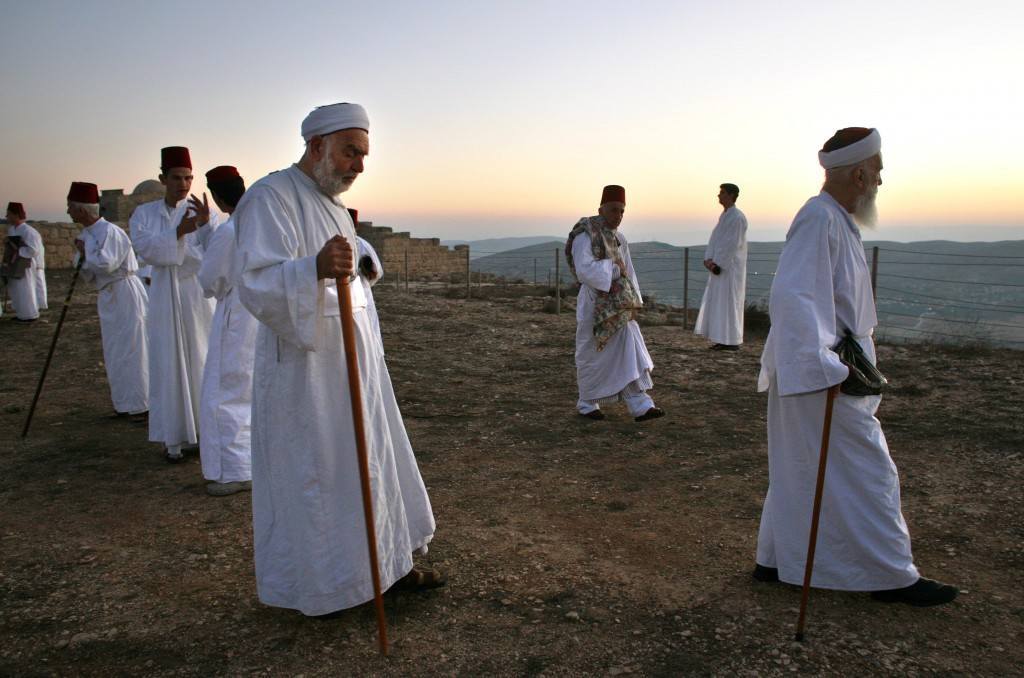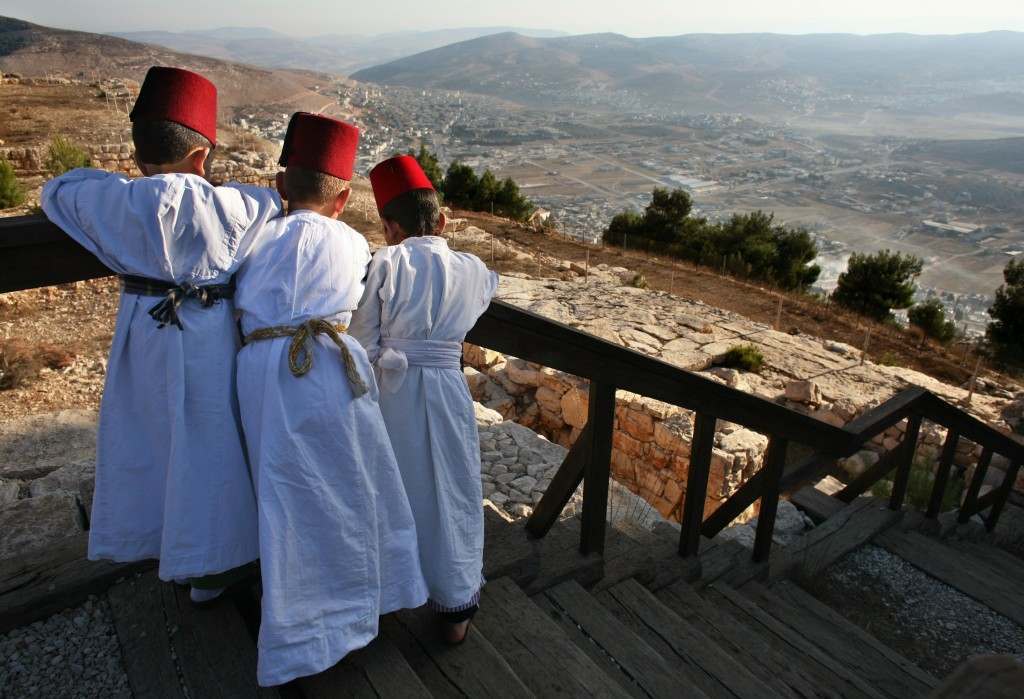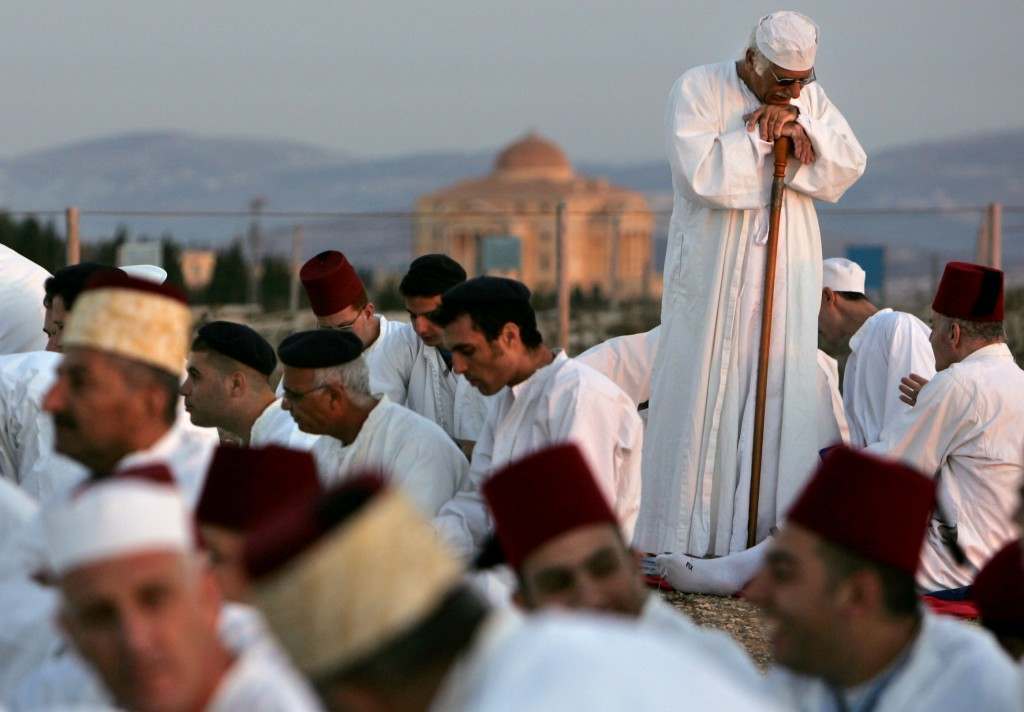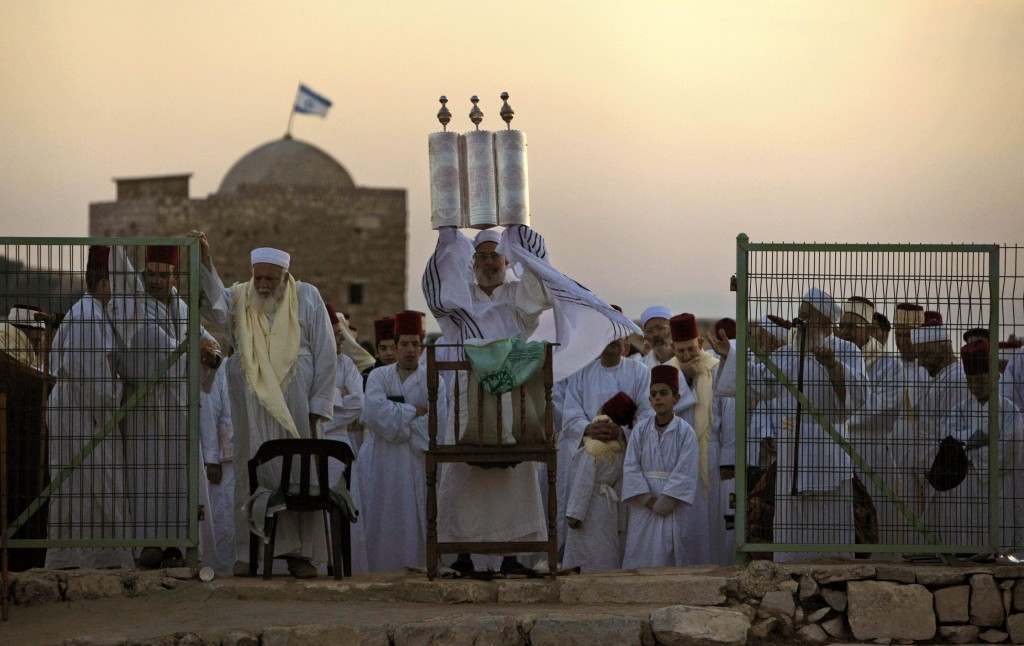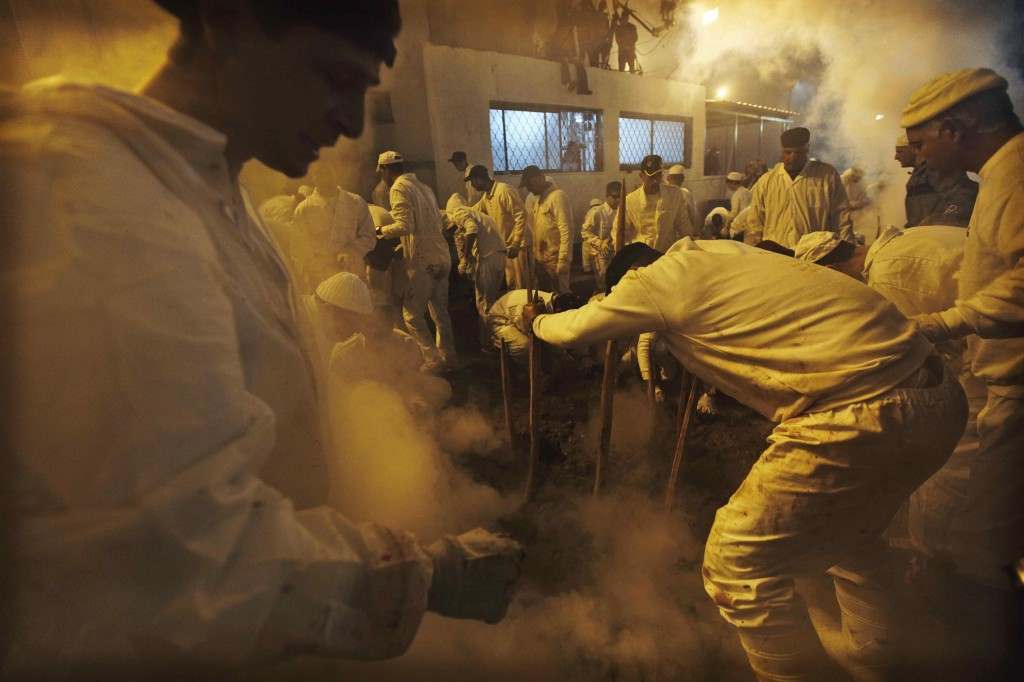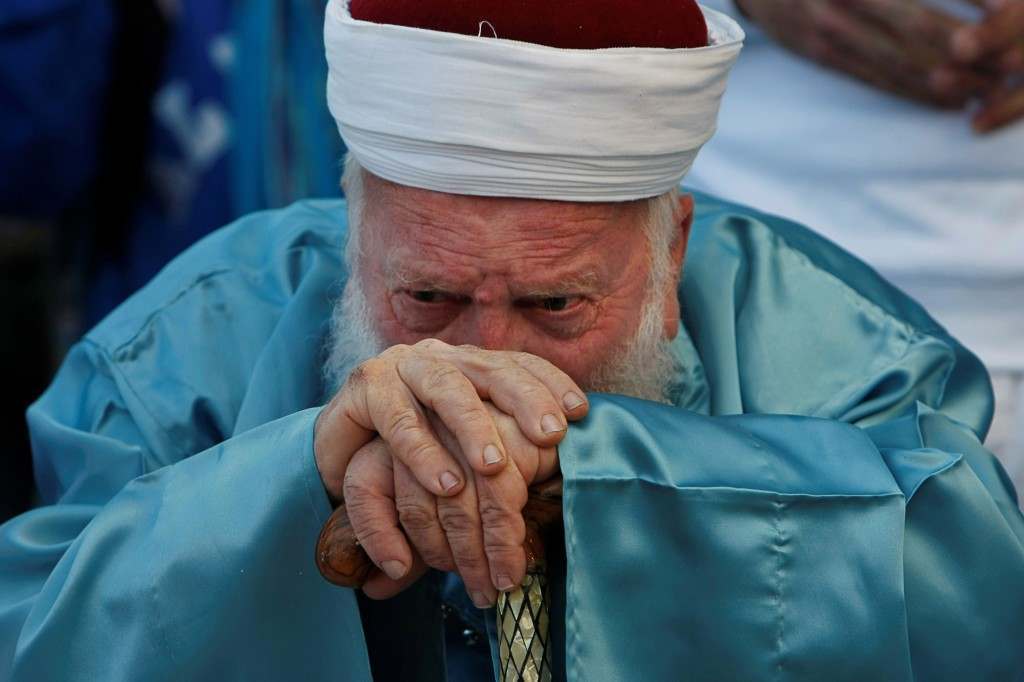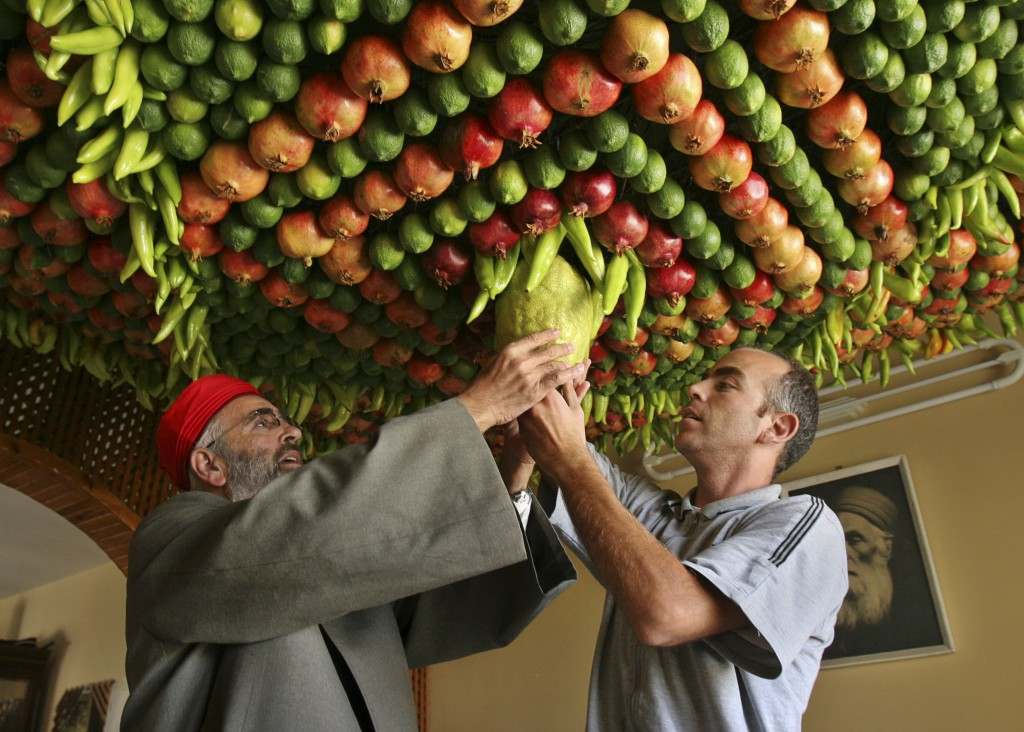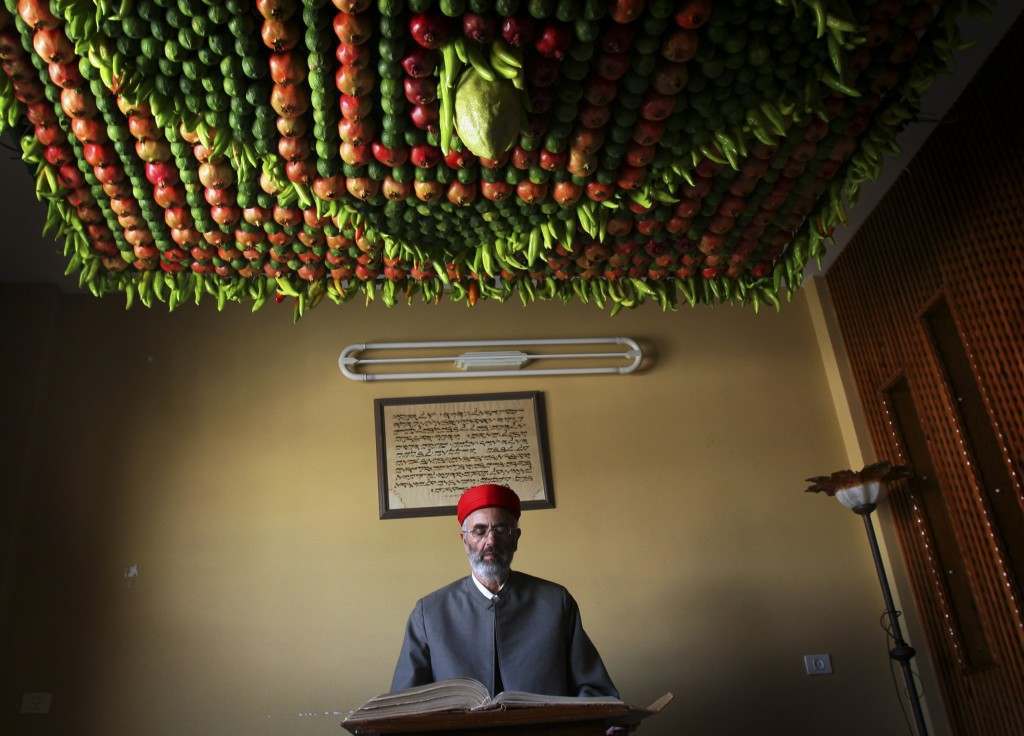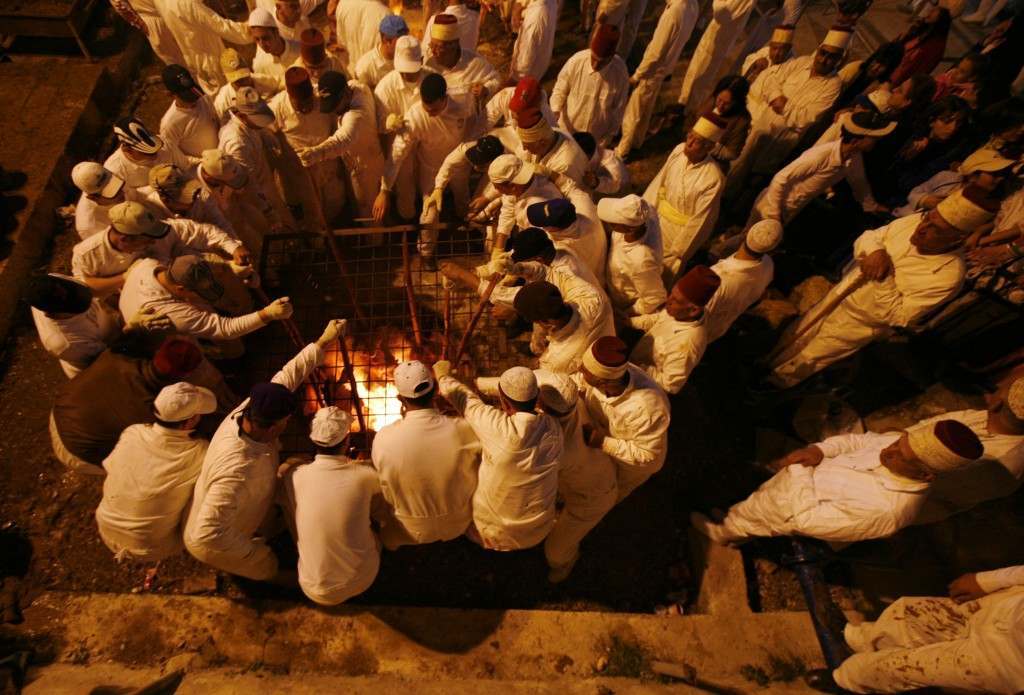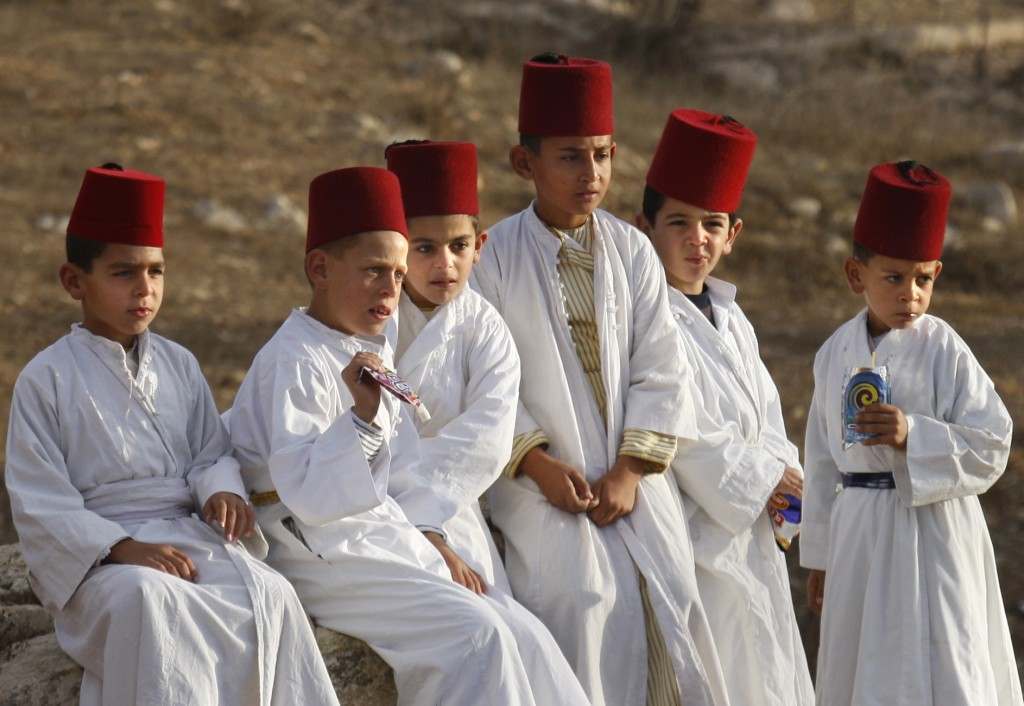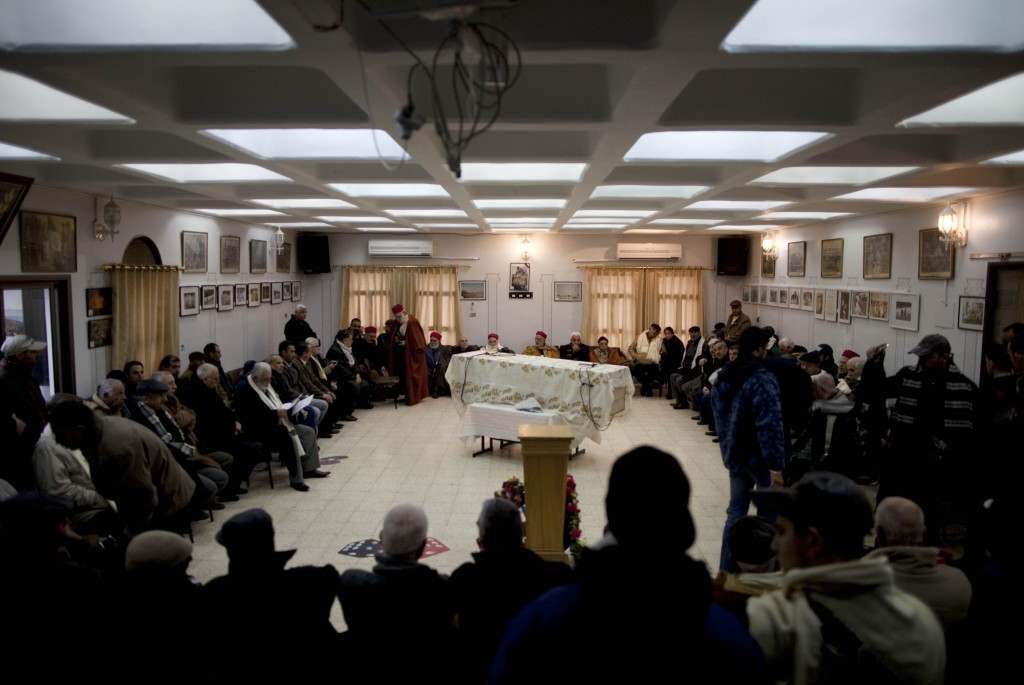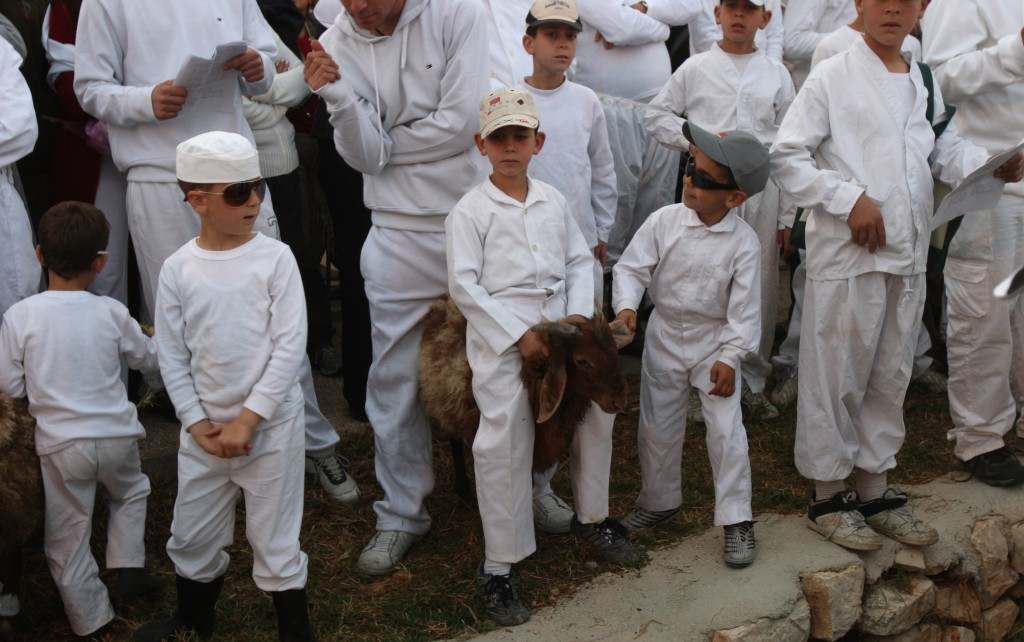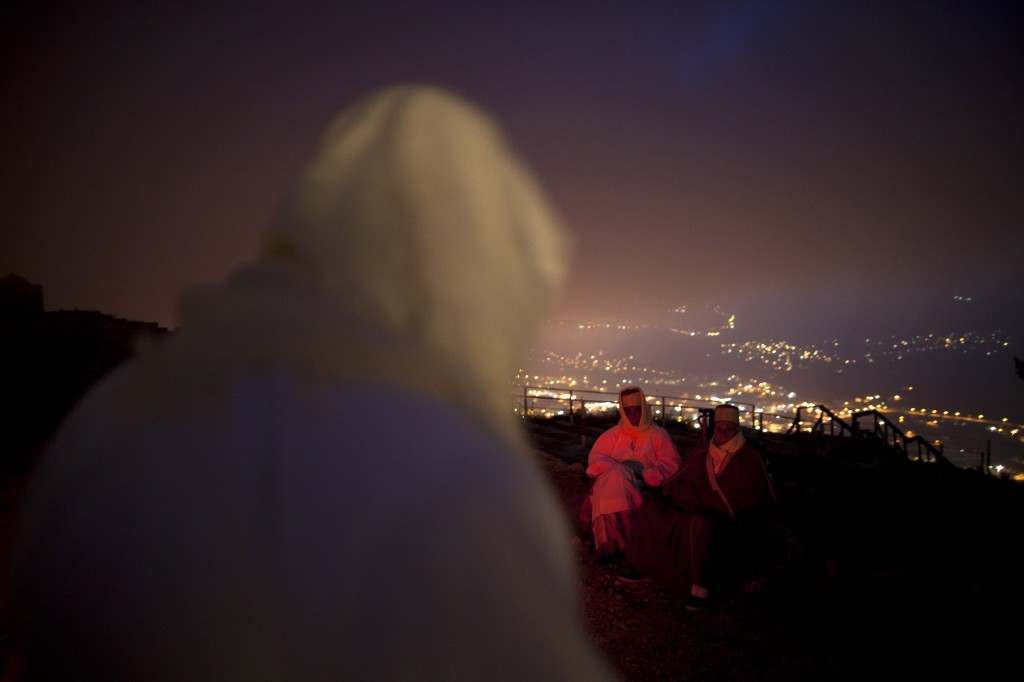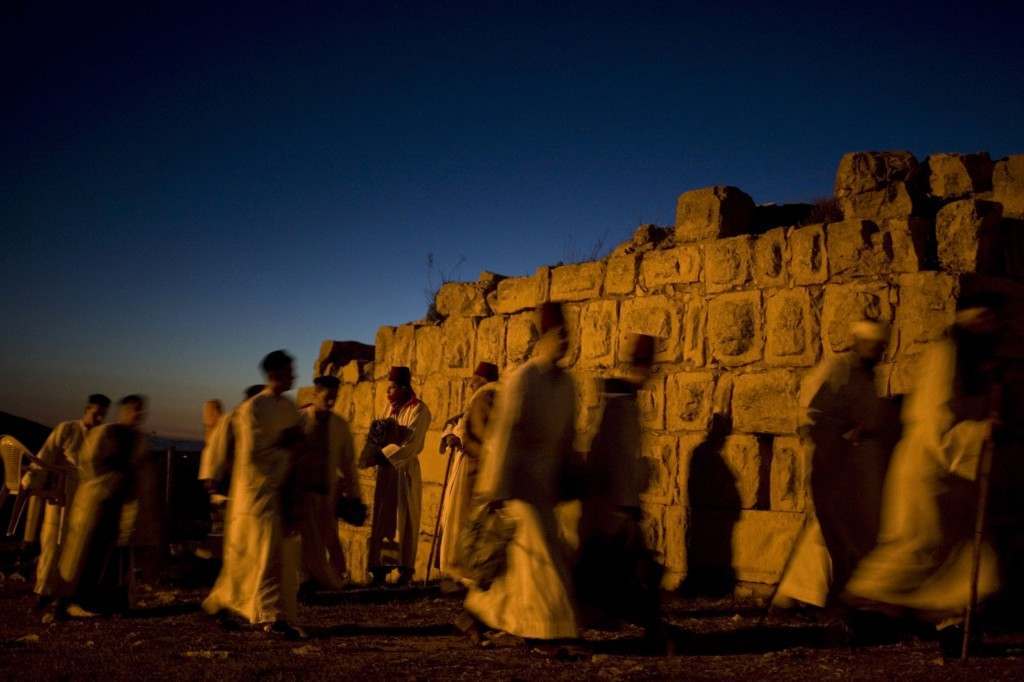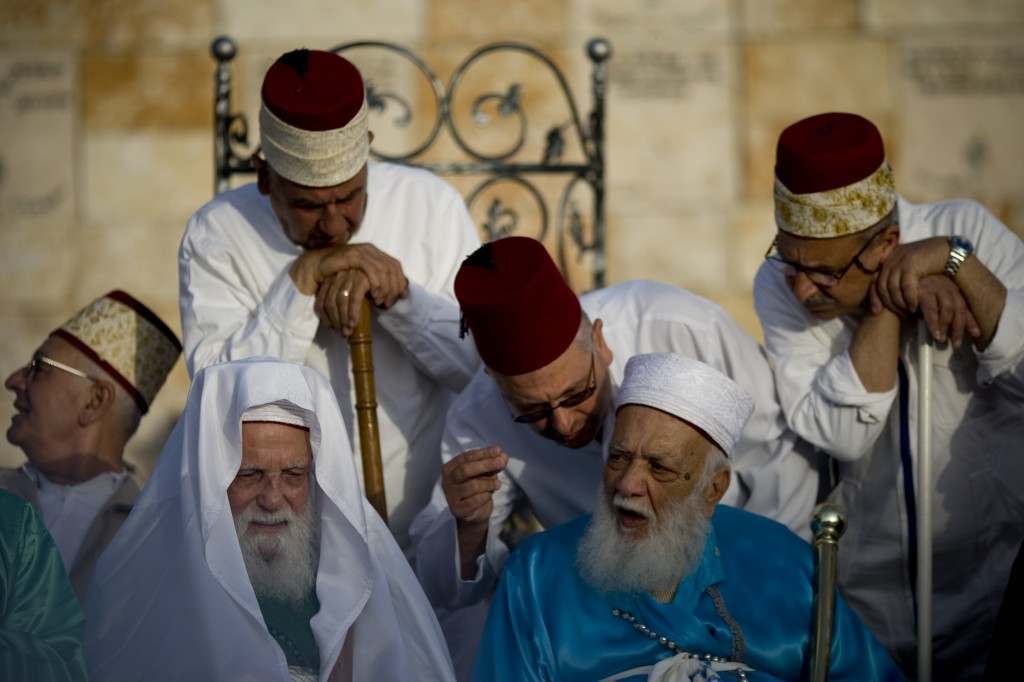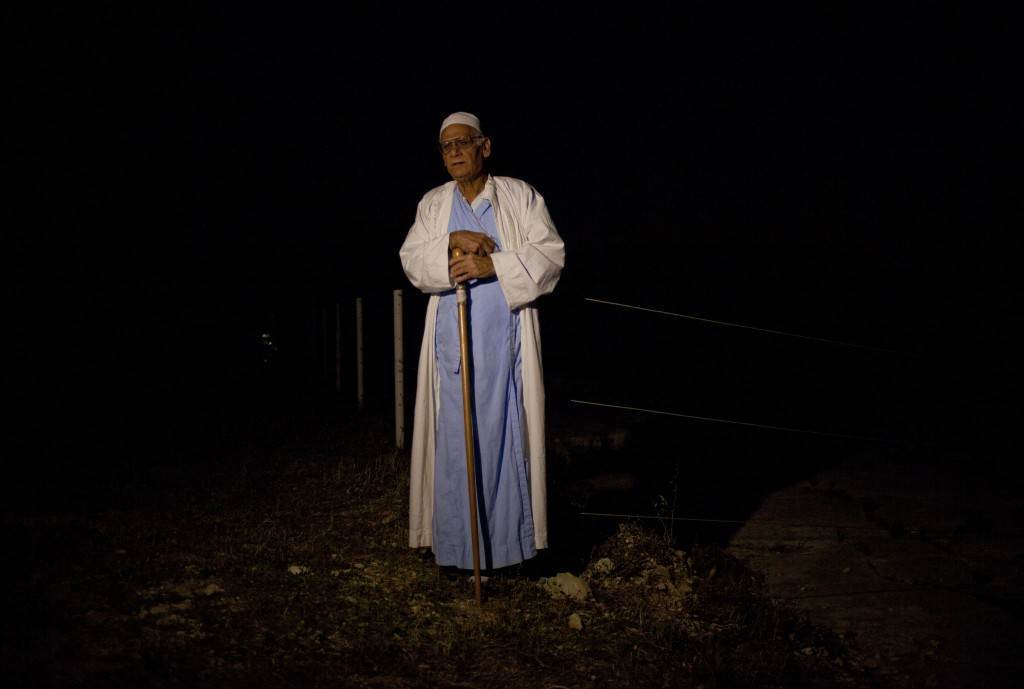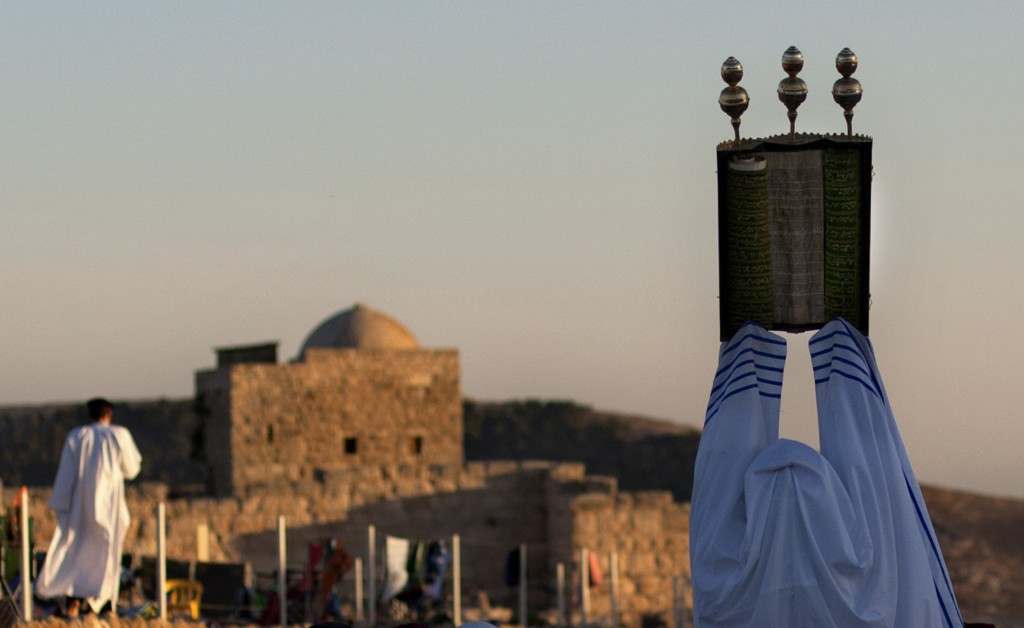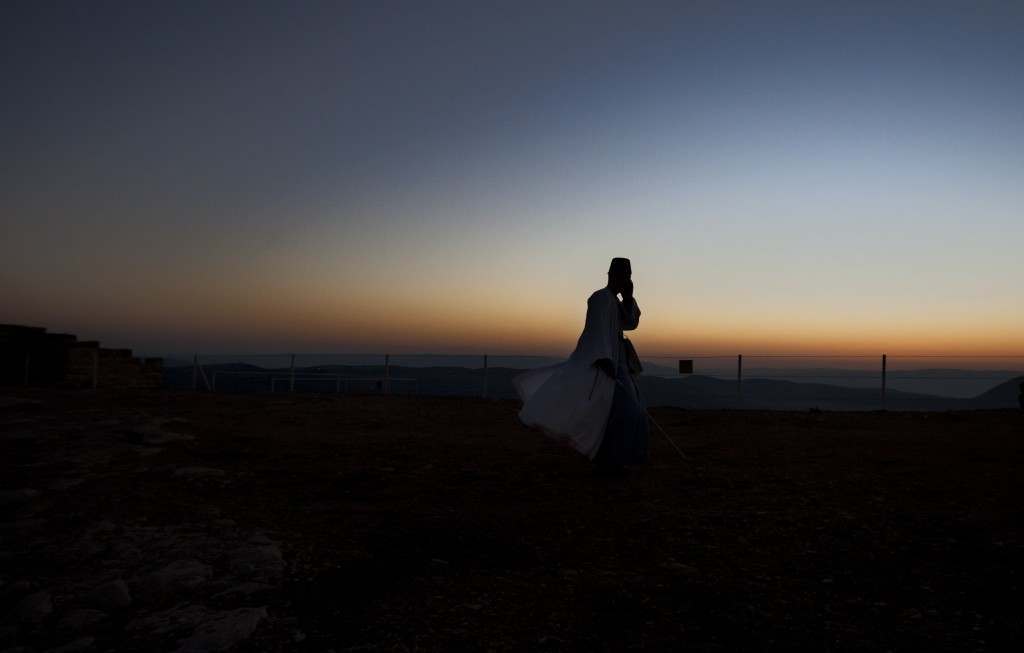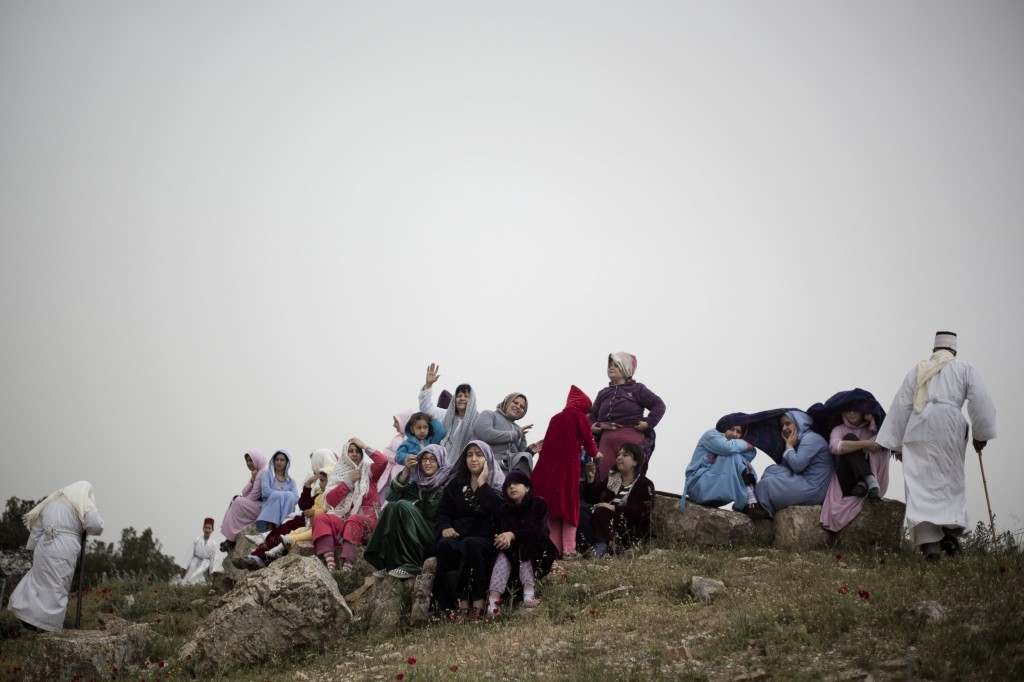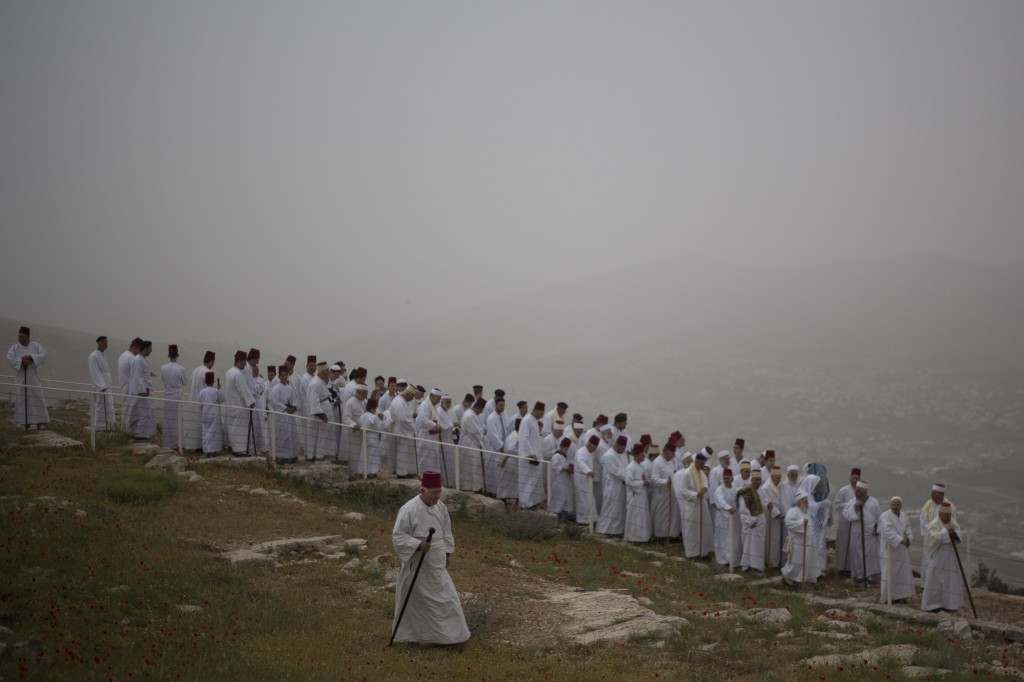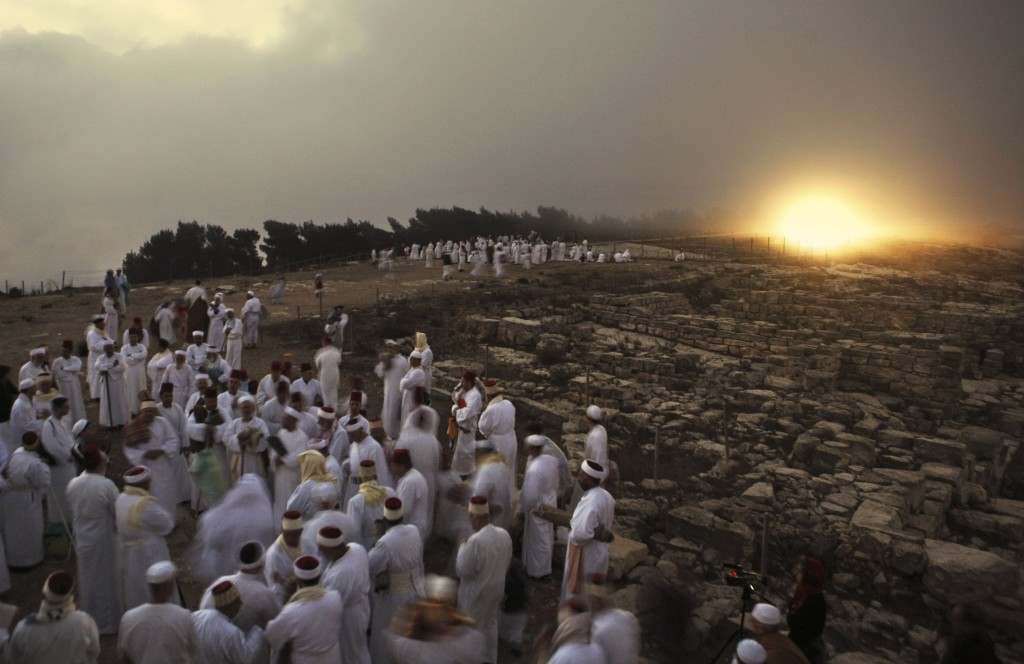
Members of the ancient Samaritan community pray during the pilgrimage for the holy day of the Tabernacles or Sukkot at the religion’s holiest site on the top of Mount Gerizim near the West Bank town of Nablus, early Thursday Oct. 25,2007. According to tradition, the Samaritans are descendants of Jews who were not deported when the Assyrians conquered Israel in the 8th century B.C. Of the small community of close to 700 people, half live in a village at Mount Gerizim, and the rest in the city of Holon near Tel Aviv. (AP Photo/Kevin Frayer)
Ref #: PA.5278274
Date: 25/10/2007
Samaritans are descended from the ancient Israelite tribes of Menashe and Efraim. They broke away from mainstream Judaism 2,800 years ago. Today, the remaining Samaritans live in the Palestinian city of Nablus in the West Bank and the Israeli seaside town of Holon, south of Tel Aviv.
According to tradition, the Samaritans are descendants of Jews who were not deported when the Assyrians conquered Israel in the 8th century B.C. Of the small community of close to 700 people, half live in a village at Mount Gerizim, and the rest in the city of Holon near Tel Aviv.
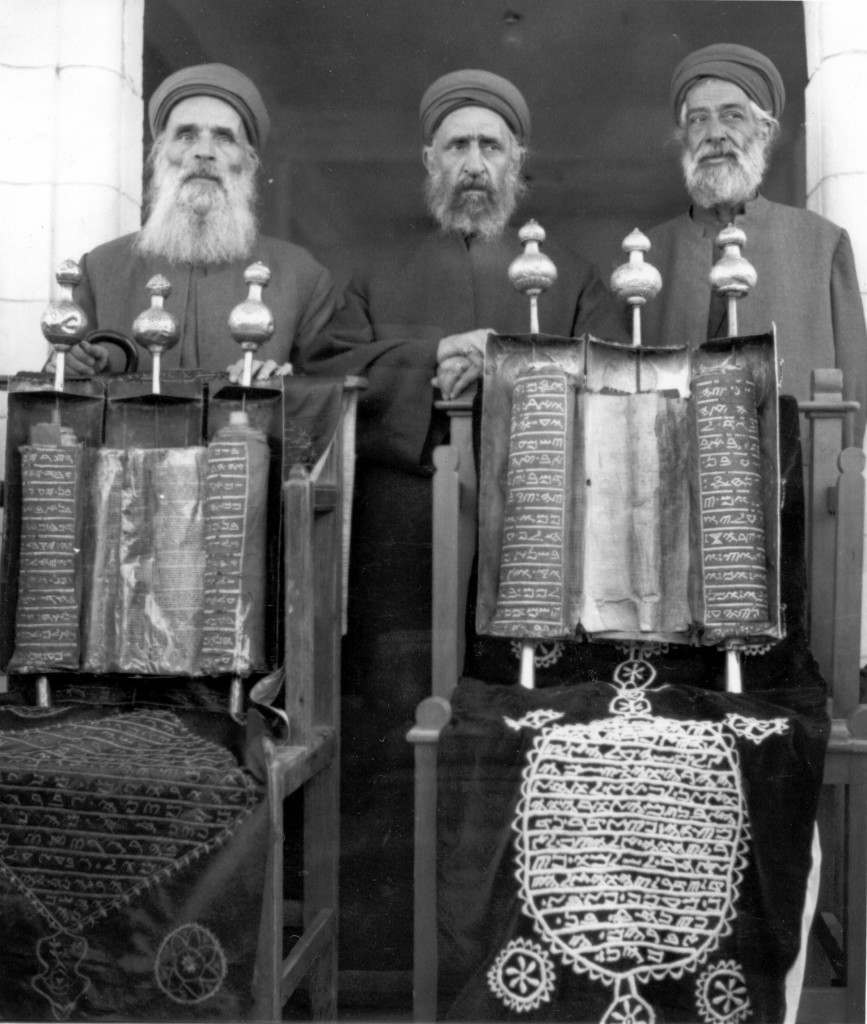
Samaritan High Priest Amran Ishak, center, and two unidentified Samaritan priests stand behind their scrolls of the Torah, or first five books of the Bible, on May 29, 1960. The Samaritans say the scroll on the right is 3,625 years old, written only 30 years after the death of Moses. These scrolls are handwritten in the primitive Hebrew alphabet. The Samaritan community live around their ancient temple site of Mount Gerizim in Nablus, Jordan. (AP Photo/Harry Koundakjian)
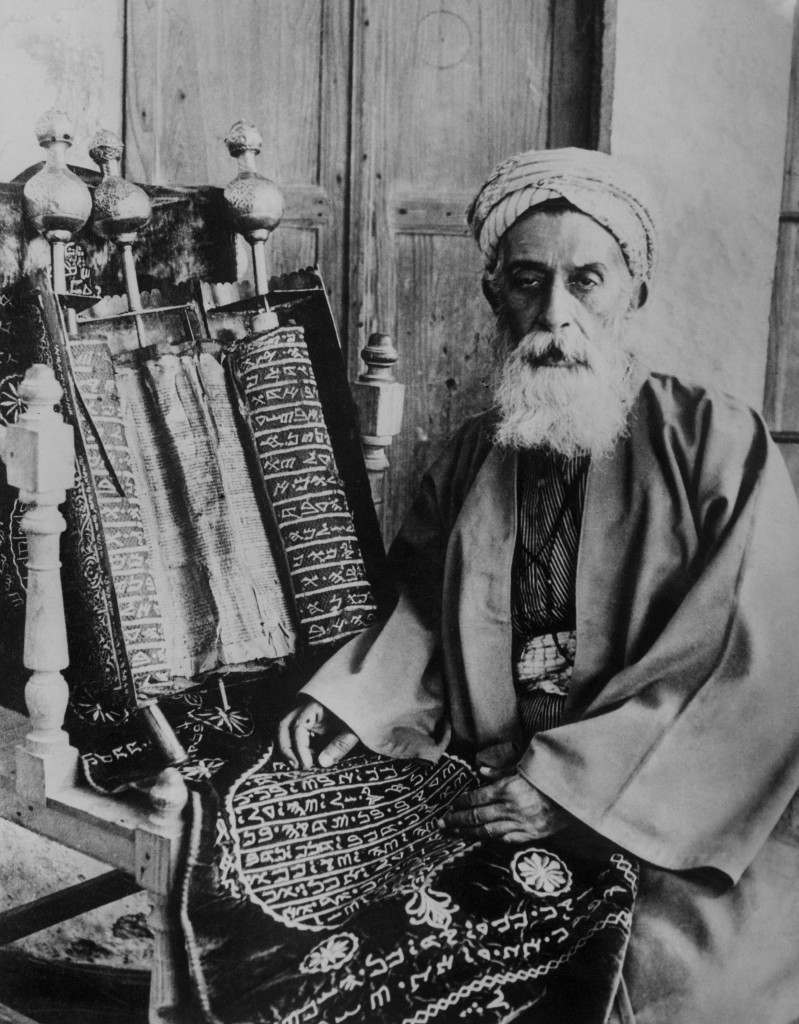
On Mount Gerizim, outside Nablus, in central Palestine, there is an ancient Jewish sect known as the Samaritans, which claim to have lived in the Holy Land continuously since the time of Moses. At Passover they conduct the ancient sacrifice of a lamb upon an altar. Aaron, the high priest of the Samaritans with some of their laws, inscribed on ancient scrolls in the Aramaic text shown May 16, 1930. (AP Photo)
Ref #: PA.8524146
Date: 16/05/1930
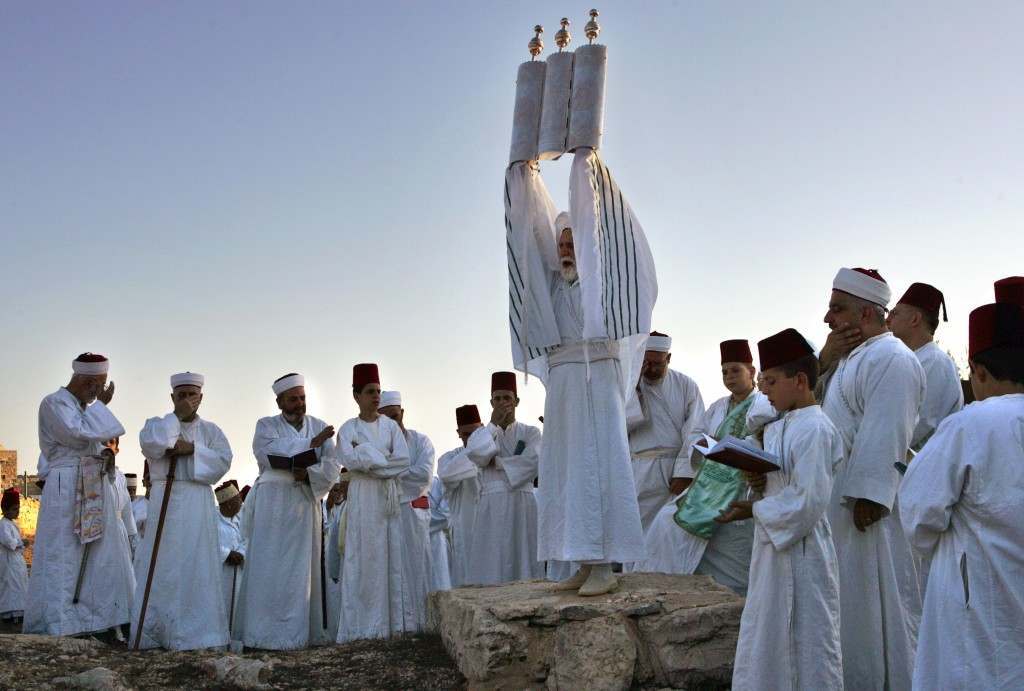
A Priest of the ancient Samaritan community, wrapped in a prayer shawl, holds up a Tora scroll as worshippers pray during the pilgrimage for the holy day of the Tabernacles or Sukkot at the religion’s holiest site on the top of Mount Gerizim near the West Bank town of Nablus, early Friday, Oct. 6, 2006. According to tradition, the Samaritans are descendants of Jews who were not deported when the Assyrians conquered Israel in the 8th century B.C. Of the small community of close to 700 people, half live in a village at Mount Gerizim, and the rest in the city of Holon near Tel Aviv. (AP Photo/Kevin Frayer)
Ref #: PA.4032853
Date: 06/10/2006
BBC:
In the fifth century, there were more than a million Samaritans.
Now, after years of persecution and forced conversions, there are just over 700 of them left.
They say they are the descendants of the ancient Israelites and they celebrate many of the same festivals as Jews – for example Sukkot, when they commemorate the 40 years that the Israelites spent in the desert.
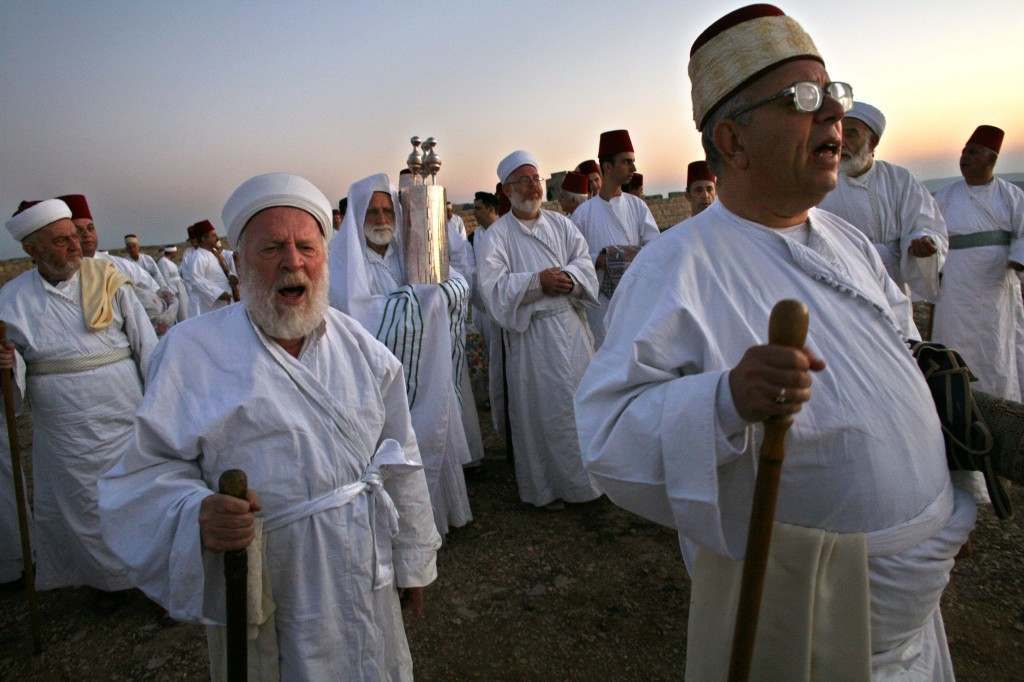
A Priest of the ancient Samaritan community, wrapped in a prayer shawl, carries a Tora scroll as worshippers walk during the pilgrimage for the holy day of the Tabernacles or Sukkot at the religion’s holiest site on the top of Mount Gerizim near the West Bank town of Nablus, early Friday, Oct. 6, 2006. According to tradition, the Samaritans are descendants of Jews who were not deported when the Assyrians conquered Israel in the 8th century B.C. Of the small community of close to 700 people, half live in a village at Mount Gerizim, and the rest in the city of Holon near Tel Aviv. (AP Photo/Kevin Frayer)
Ref #: PA.4032854
Date: 06/10/2006
Few events attract such a colorful array of visitors as this ancient annual Passover ceremony — where the sheep are slaughtered by each family in a sacrificial ritual, roasted through the night, and eaten — and where earlocked ultra-Orthodox men garbed in black and white mix with veiled young Palestinian women and tourists from Europe and the Far East; and where Israeli soldiers stand guard next to Palestinian firefighters.
The Samaritans trace their lineage back to the biblical tribes of Menashe and Ephraim, the sons of Joseph. They defied imperial conquests and clung to the land while much of the population of the Northern Kingdom of Israel was exiled to Assyria — presently northern Iraq — by King Sargon II in 722 BCE.
But Jews have a significantly different version of events. According to the biblical narrative in the Second Book of Kings, the Assyrian king repopulated desolate Samaria with various indigenous peoples including the Cutheans, who, the Jews believed, the Samaritans descended from. When exiled Jews began returning to Jerusalem from Babylon in the 6th century BCE and building the Second Temple, they refused to recognize the Samaritans as coreligionists.
To this day, Badawiya Samiri explained, it is the stringent religious upbringing that keeps Samaritans from leaving the fold. A Samaritan child has a bar mitzvah at the tender age of 6 after having recited the entire Torah cycle. So when, at 13, the child begins high school in Nablus, “it is unlikely that other ideas will affect him.”

Samaritans watch slaughtered sheep during the ritual of Sacrifice, part of a Passover ceremony, in Mount Grizin, overlooking the West Bank town of Nablus, Tuesday April 11, 2006. Samaritans descended from the ancient Israelite tribes of Menashe and Efraim but broke away from mainstream Judaism 2,800 years ago. Today, the remaining 700 Samaritans, live in the Palestinian city of Nablus in the West Bank and the Israeli seaside town of Holon, south of Tel Aviv. (AP Photo/Baz Ratner)
Ref #: PA.3410614
Date: 12/04/2006
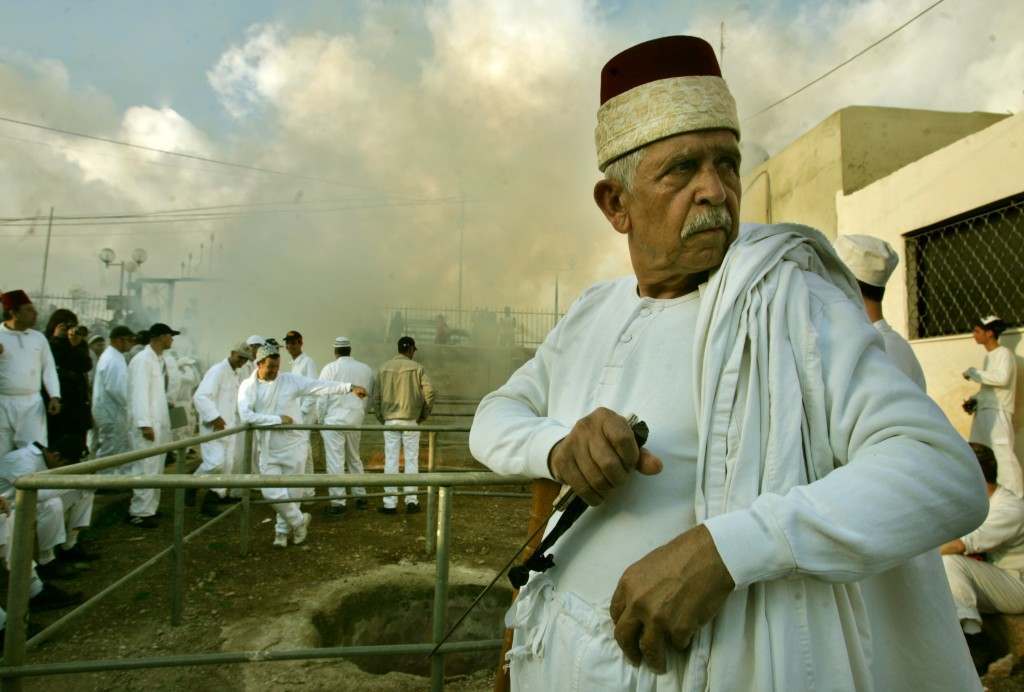
A Samaritan priest holds a knife before slaughtering sheep during the ritual of Sacrifice, part of a Samaritan Passover ceremony, in Mount Grizin, overlooking the West Bank town of Nablus, Tuesday April 11, 2006. Samaritans descended from the ancient Israelite tribes of Menashe and Efraim but broke away from mainstream Judaism 2,800 years ago. Today, the remaining 700 Samaritans, live in the Palestinian city of Nablus in the West Bank and the Israeli seaside town of Holon, south of Tel Aviv.(AP Photo/Baz Ratner)
Ref #: PA.3410498
Date: 12/04/2006
For decades, it seemed as though one of the world’s smallest religious communities was doomed. Dwindling and insular, the Samaritans of Mount Gerizim were struggling to survive as inbreeding produced generation after generation of children with serious disabilities on an isolated hilltop in the biblical landscape of the West Bank.
But the threat of extinction is now receding after the deployment of the twin weapons of advanced medical science and internet marriage agencies to import brides from Ukraine. In fact, the community of four extended families totalling 320 people is now looking forward to rapid growth.
“We’re hoping our numbers will reach 10,000 in 10 years,” jokes high priest Aharon Ben-Av Chisda, with more optimism than realistic prediction. “Before, we were worried about the future of our community. Now we have hope.”
Much of this hope stems from five young Ukrainian women who have injected fresh blood to Mount Gerizim after swapping a life of bleak prospects, dismal housing and badly paid employment for space, security and strict observance of the religious dictates of the ancient Samaritan community.
Alla Altif, 25, the third bride to make the journey from the shores of the Black Sea to the hills of the West Bank, had “no idea what to expect. I was in an uncertain situation, I felt a bit shaky.” At first, she says, the isolation was a shock. “But now I prefer it to a big city – it’s quiet and peaceful and the air is good.” And she and her husband, Uzi, have fulfilled the purpose of their match: they have a healthy son, Morad, who will be two next month.
The women, located by specialist internet-based agencies, have converted from Christianity in order to join the community, whose members are forbidden from marrying non-Samaritans. The brides now adhere to strict biblical traditions, including isolation during menstruation and for long periods following childbirth…
In the 1990s, when the Samaritans at Mount Gerizim were granted Israeli citizenship, they gained access to Israel’s hi-tech hospitals, among the most advanced in the world. Routine genetic testing was introduced in the pregnancies of Samaritan women, and abortions were encouraged whenever the risk of birth defects was higher than 10%. Around one in five pregnancies is now terminated, and in the past 15 years, only two disabled children have been born – one as a result of oxygen deprivation during labour, and the other a child whose parents failed to complete the full range of tests during pregnancy. “Genetic testing has vastly improved things,” says Ben-Av Chisda, who presides over the Mount Gerizim community and another, 450-strong, in Holon, Israel.
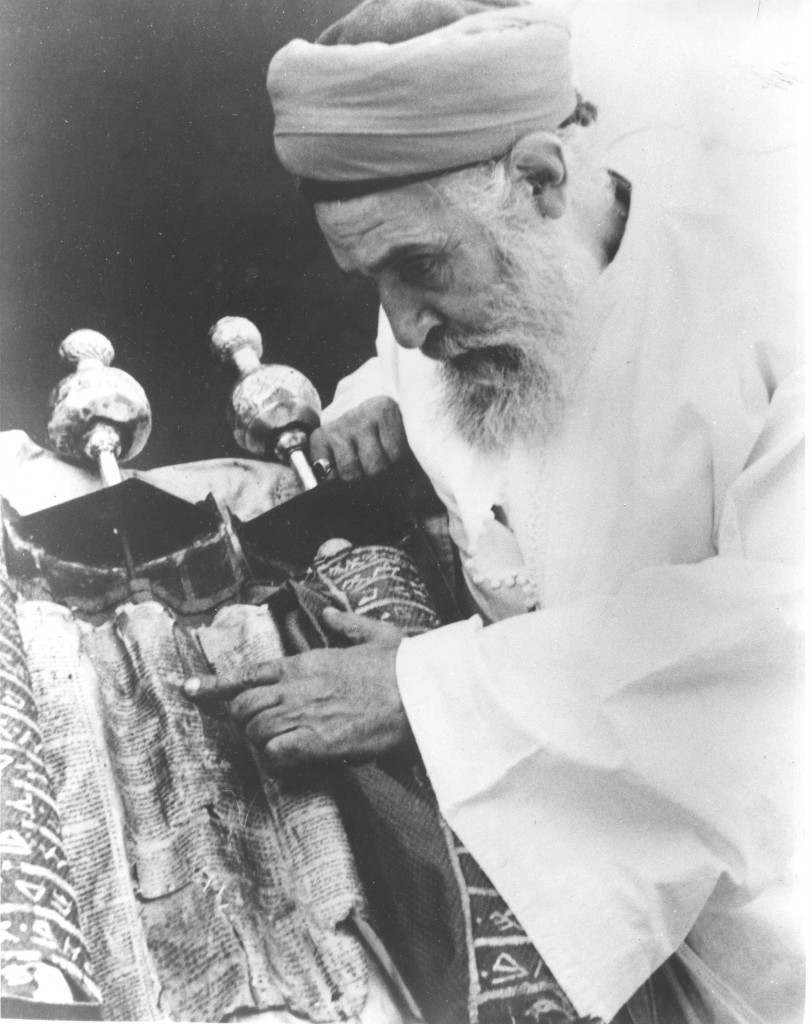
A Samaritan Jew patriarch points to the words of the Torah, or Law of Moses, on the scroll in Nablus, Jordan, circa 1952. (AP Photo/Harry Koundakjian)
Ref #: PA.8666761
Date: 12/11/2002
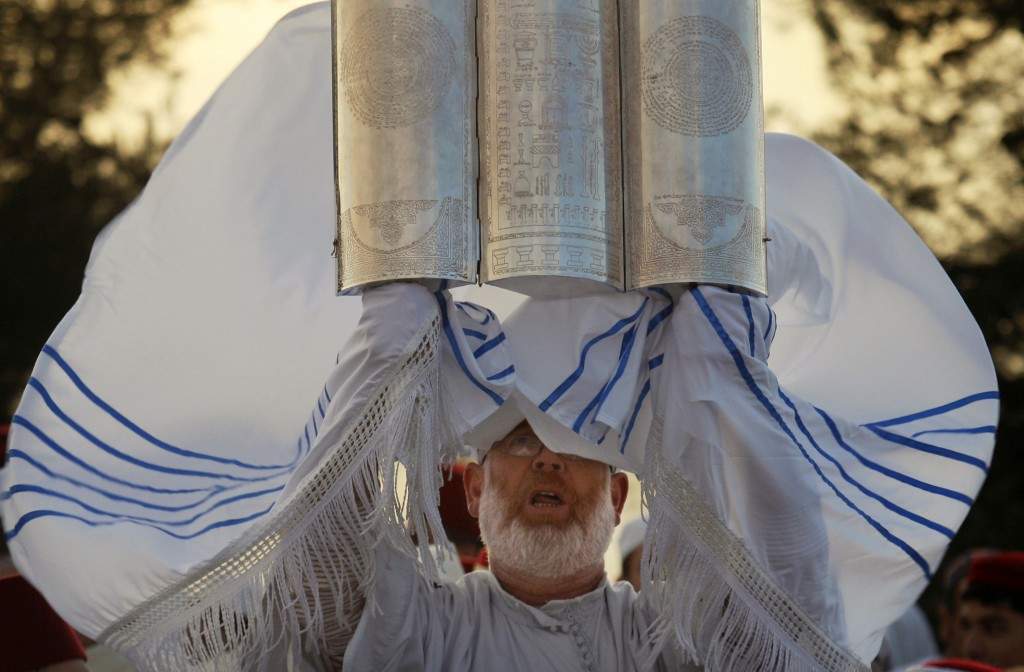
A Priest of the ancient Samaritan community, wrapped in a prayer shawl, holds up a Tora scroll during the pilgrimage for the holy day of the Tabernacles or Sukkot at the religion’s holiest site on the top of Mount Gerizim near the West Bank town of Nablus, early Thursday Oct. 25,2007. According to tradition, the Samaritans are descendants of Jews who were not deported when the Assyrians conquered Israel in the 8th century B.C. Of the small community of close to 700 people, half live in a village at Mount Gerizim, and the rest in the city of Holon near Tel Aviv. (AP Photo/Kevin Frayer)
Ref #: PA.5278431
Date: 25/10/2007
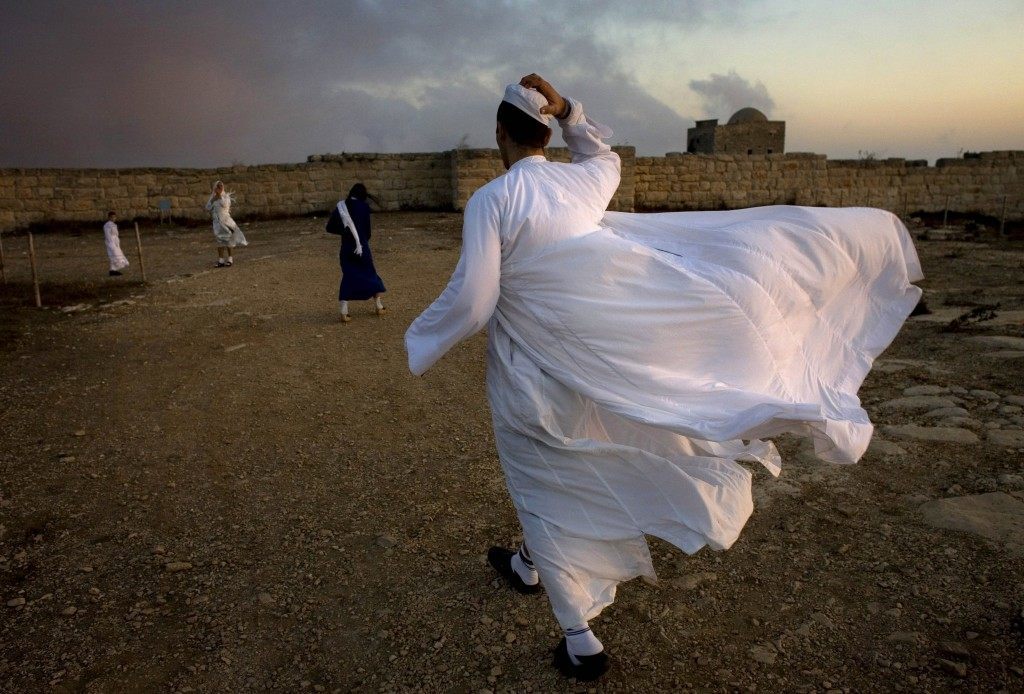
A priest of the ancient Samaritan community walks during the pilgrimage for the holy day of the Tabernacles or Sukkot at the religion’s holiest site on the top of Mount Gerizim near the West Bank town of Nablus.
Picture date: Thursday Oct. 25, 2007. According to tradition, the Samaritans are descendants of Jews who were not deported when the Assyrians conquered Israel in the 8th century B.C. Of the small community of close to 700 people, half live in a village at Mount Gerizim, and the rest in the city of Holon near Tel Aviv. (AP Photo/Oded Balilty)
Ref #: PA.5278445
Date: 25/10/2007
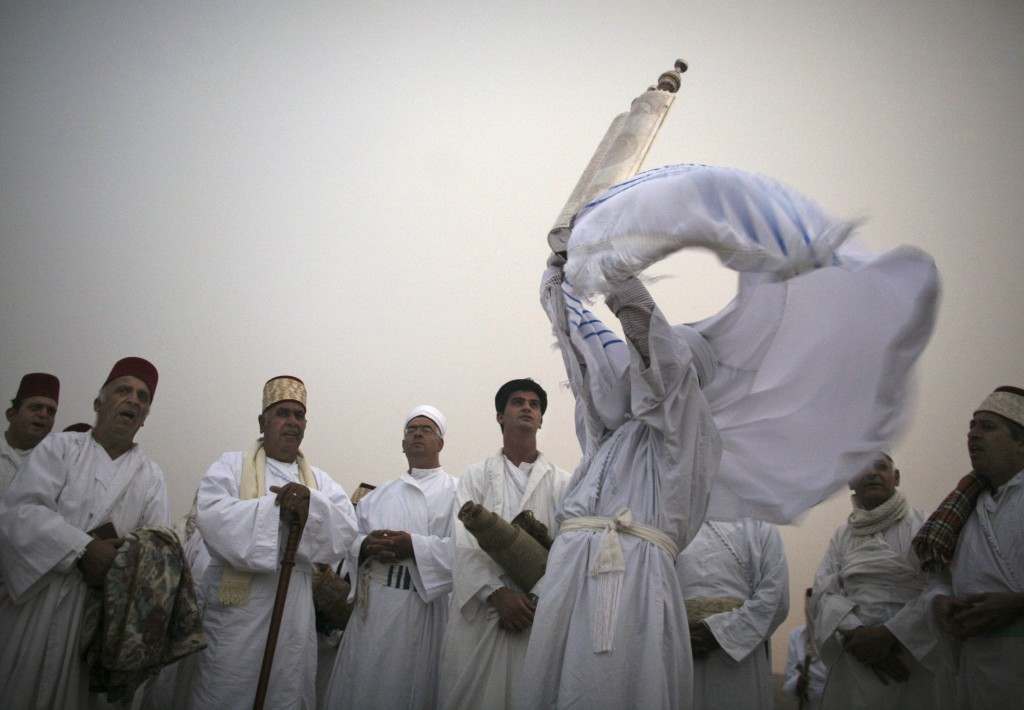
A priest of the ancient Samaritan community, wrapped in a prayer shawl, holds up a Tora scroll as worshippers pray during the pilgrimage for the holy day of the Tabernacles or Sukkot at the religion’s holiest site on the top of Mount Gerizim near the West Bank town of Nablus, early Thursday Oct. 25,2007. According to tradition, the Samaritans are descendants of Jews who were not deported when the Assyrians conquered Israel in the 8th century B.C. Of the small community of close to 700 people, half live in a village at Mount Gerizim, and the rest in the city of Holon near Tel Aviv. (AP Photo/Kevin Frayer)
Ref #: PA.5278417
Date: 25/10/2007
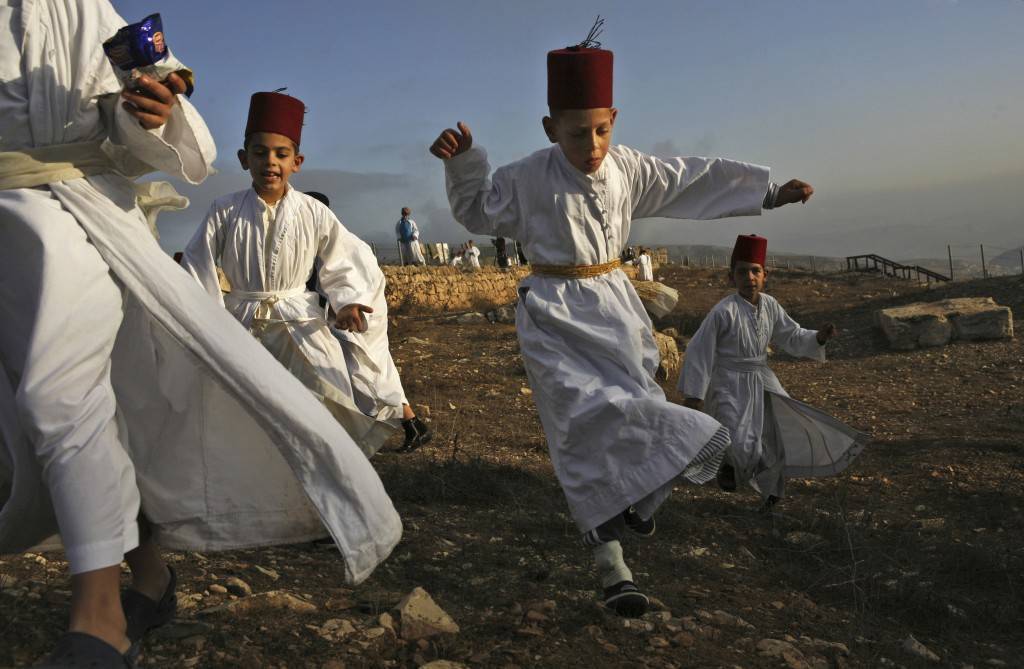
Samaritan children play during the pilgrimage for the holy day of the Tabernacles or Sukkot at the religion’s holiest site on the top of Mount Gerizim near the West Bank town of Nablus, early Thursday Oct. 25,2007. According to tradition, the Samaritans are descendants of Jews who were not deported when the Assyrians conquered Israel in the 8th century B.C. Of the small community of close to 700 people, half live in a village at Mount Gerizim, and the rest in the city of Holon near Tel Aviv. (AP Photo/Kevin Frayer)
Ref #: PA.5278409
Date: 25/10/2007
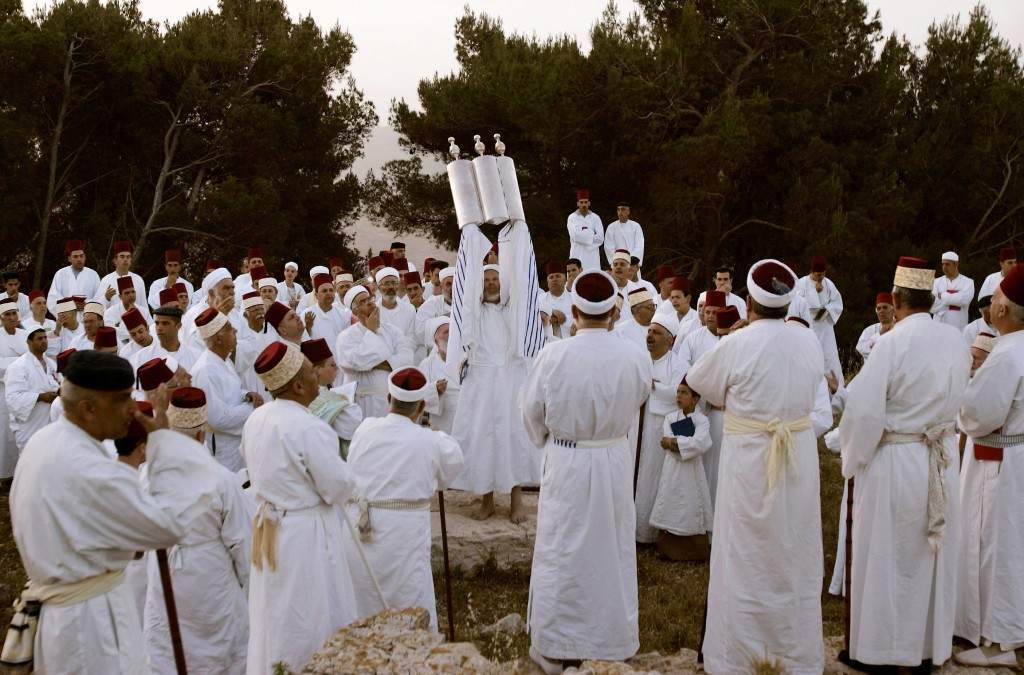
A priest of the Ancient Samaritan community holds up a scroll during a pilgrimage marking the end of the holy day of Passover at the religion’s holiest site on Mount Gerizim near the West Bank town of Nablus, early Monday, May 7, 2007. According to tradition, the Samaritans are descendants of Jews who were not deported when the Assyrians conquered the area in the 8th century B.C. Of the small community of close to 700 people, half live in a village at Mount Gerizim, and the rest in the city of Holon near Tel Aviv. (AP PhotoAriel Schalit)
Ref #: PA.4631695
Date: 07/05/2007
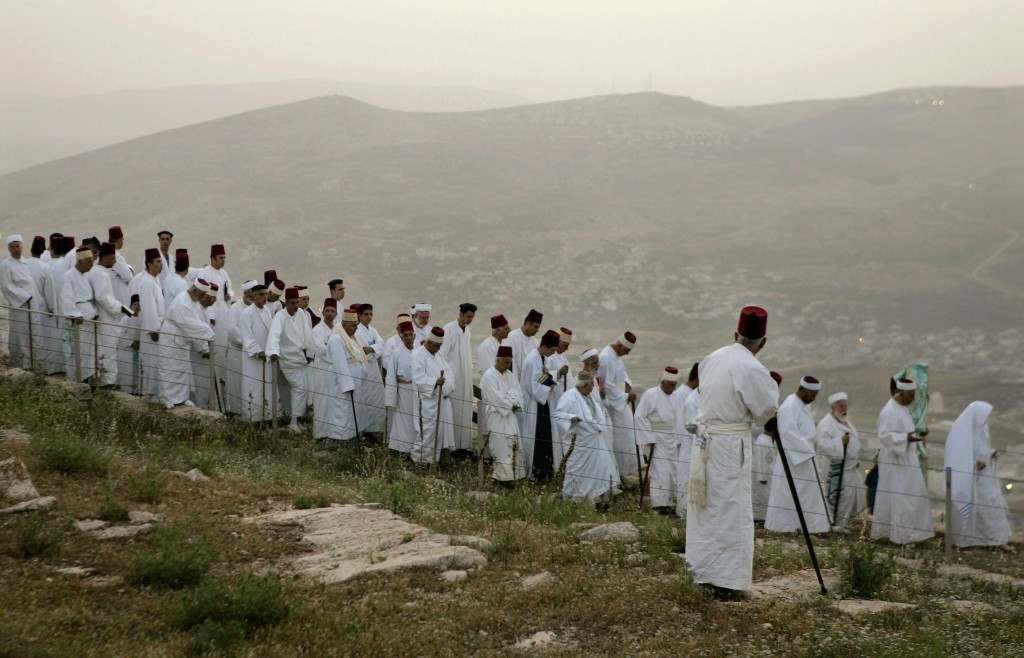
Members of the Ancient Samaritan community walk during a pilgrimage marking the end of the holy day of Passover at the religion’s holiest site on Mount Gerizim near the West Bank town of Nablus, early Monday, May 7, 2007. According to tradition, the Samaritans are descendants of Jews who were not deported when the Assyrians conquered the area in the 8th century B.C. Of the small community of close to 700 people, half live in a village at Mount Gerizim, and the rest in the city of Holon near Tel Aviv. (AP Photo/Ariel Schalit)
Ref #: PA.4631688
Date: 07/05/2007

Members of the Ancient Samaritan community pray during a pilgrimage marking the end of the holy day of Passover at the religion’s holiest site on Mount Gerizim near the West Bank town of Nablus, early Monday, May 7, 2007. According to tradition, the Samaritans are descendants of Jews who were not deported when the Assyrians conquered the area in the 8th century B.C. Of the small community of close to 700 people, half live in a village at Mount Gerizim, and the rest in the city of Holon near Tel Aviv. (AP Photo/Ariel Schalit)
Ref #: PA.4631692
Date: 07/05/2007

A father from the Ancient Samaritan community holds up his son during a pilgrimage marking the end of the holy day of Passover at the religion’s holiest site on Mount Gerizim near the West Bank town of Nablus, early Monday, May 7, 2007. According to tradition, the Samaritans are descendants of Jews who were not deported when the Assyrians conquered the area in the 8th century B.C. Of the small community of close to 700 people, half live in a village at Mount Gerizim, and the rest in the city of Holon near Tel Aviv. (AP PhotoAriel Schalit)
Ref #: PA.4631675
Date: 07/05/2007
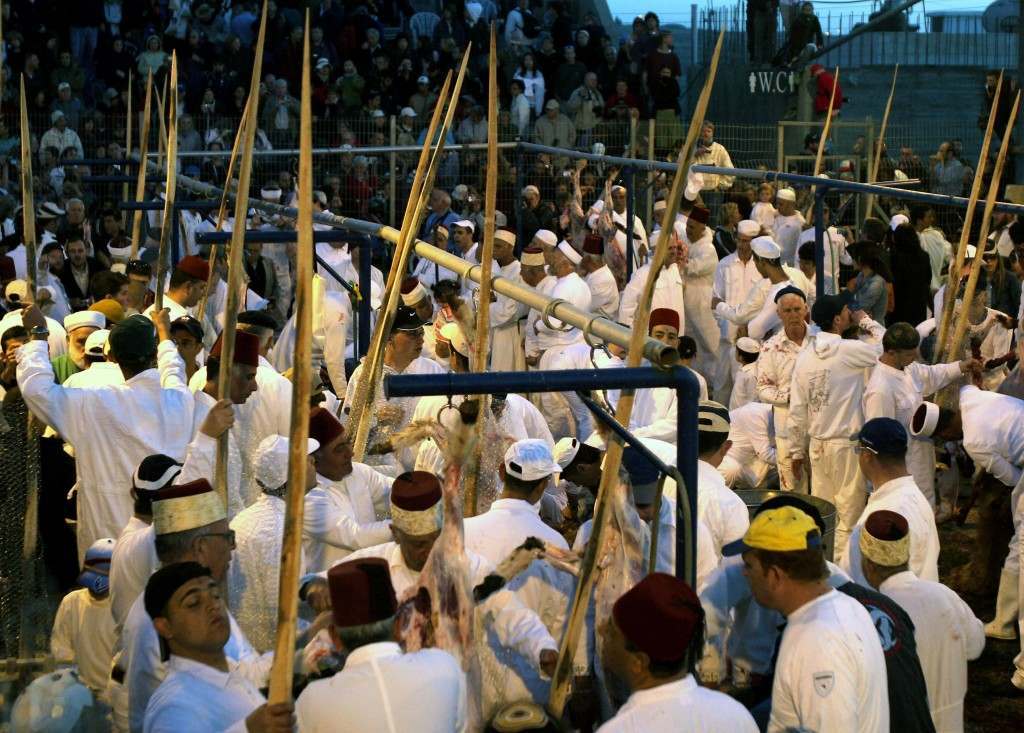
Samaritans hold wooden stakes used to cook slaughtered sheep during the ritual of Sacrifice, part of a Passover ceremony, in Mount Gerezim, overlooking the West Bank town of Nablus, Monday, April 30, 2007. According to tradition, the Samaritans are descendants of Jews who were not deported when the Assyrians conquered Israel in the 8th century B.C. Of the small community of close to 700 people, half live in a village at Mount Gerizim, and the rest in the city of Holon near Tel Aviv. (AP Photo/Nasser Ishtayeh)
Ref #: PA.4613082
Date: 01/05/2007
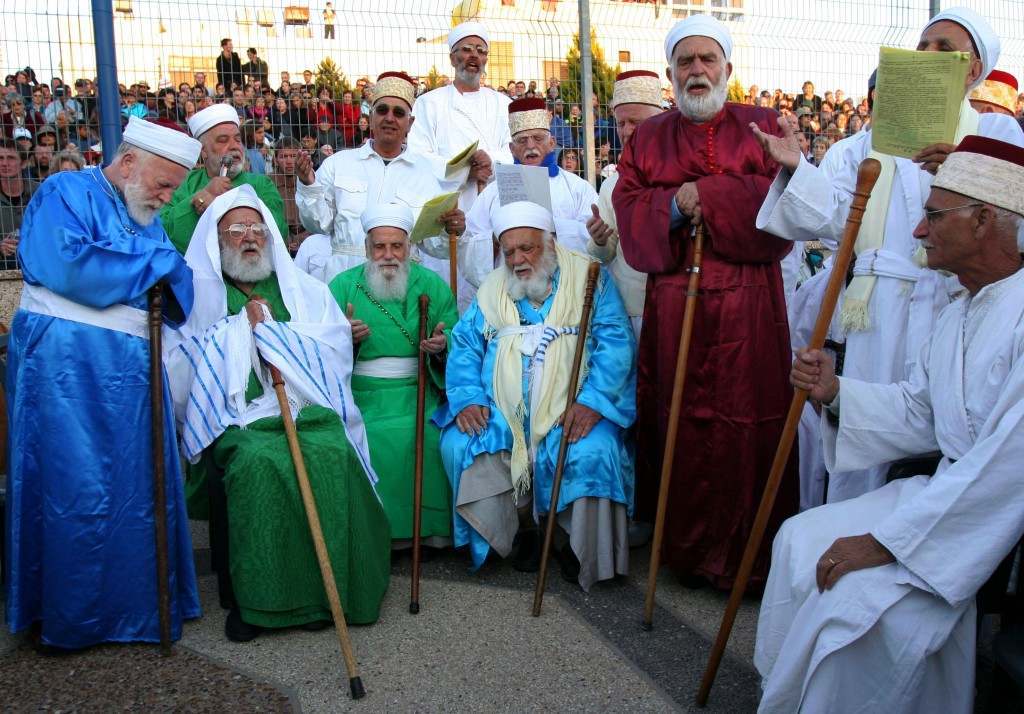
Samaritan priests pray during the ritual of Sacrifice, part of a Passover ceremony, in Mount Gerezim, overlooking the West Bank town of Nablus, Monday, April 30, 2007. According to tradition, the Samaritans are descendants of Jews who were not deported when the Assyrians conquered Israel in the 8th century B.C. Of the small community of close to 700 people, half live in a village at Mount Gerizim, and the rest in the city of Holon near Tel Aviv. (AP Photo/Nasser Ishtayeh)
Ref #: PA.4613081
Date: 01/05/2007
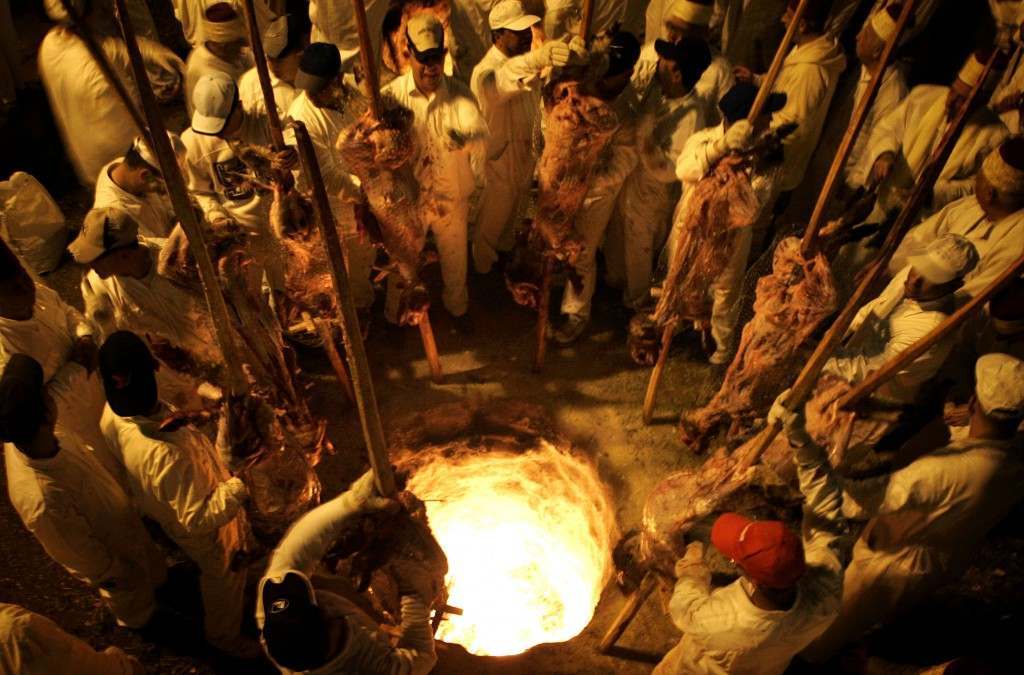
Samaritans priest insert their skewered Passover sacrifices into the oven during the ritual of Sacrifice, part of a Samaritan Passover ceremony, in Mount Grizin, overlooking the West Bank town of Nablus, Tuesday May 1, 2007. Samaritans descended from the ancient Israelite tribes of Menashe and Efraim but broke away from mainstream Judaism 2,800 years ago. Today, the remaining 700 Samaritans, live in the Palestinian city of Nablus in the West Bank and the Israeli seaside town of Holon, south of Tel Aviv. (AP Photo/Emilio Morenatti)
Ref #: PA.4614147
Date: 25/04/2007
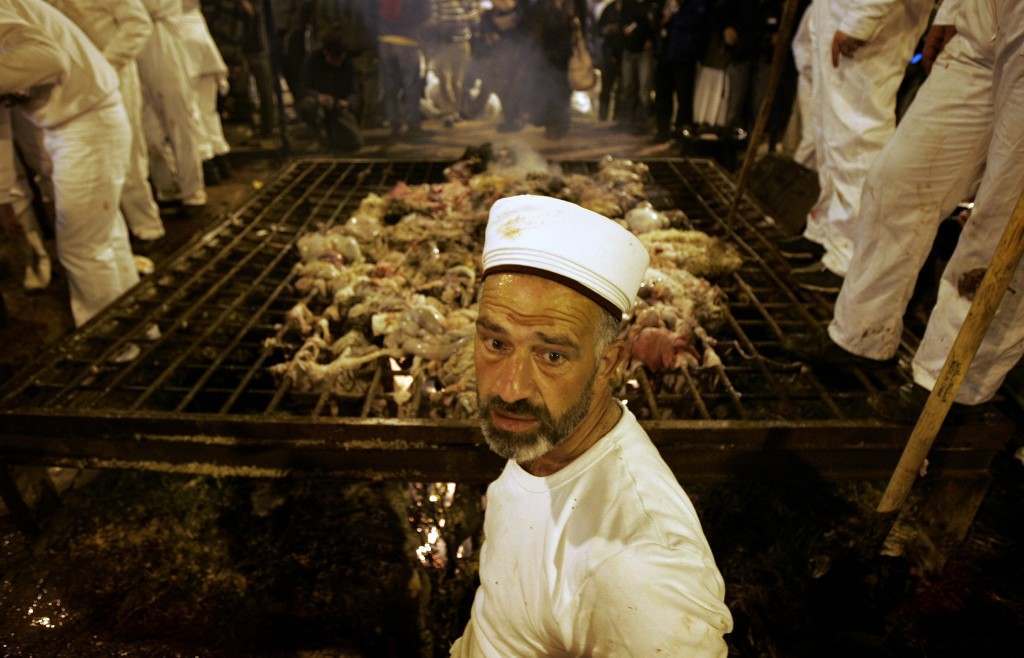
Samaritans priest burn the entrails of sheep during the ritual of Sacrifice, part of a Samaritan Passover ceremony, in Mount Grizin, overlooking the West Bank town of Nablus, Tuesday May 1, 2007. Samaritans descended from the ancient Israelite tribes of Menashe and Efraim but broke away from mainstream Judaism 2,800 years ago. Today, the remaining 700 Samaritans, live in the Palestinian city of Nablus in the West Bank and the Israeli seaside town of Holon, south of Tel Aviv. (AP Photo/Emilio Morenatti)
Ref #: PA.4613085
Date: 25/04/2007
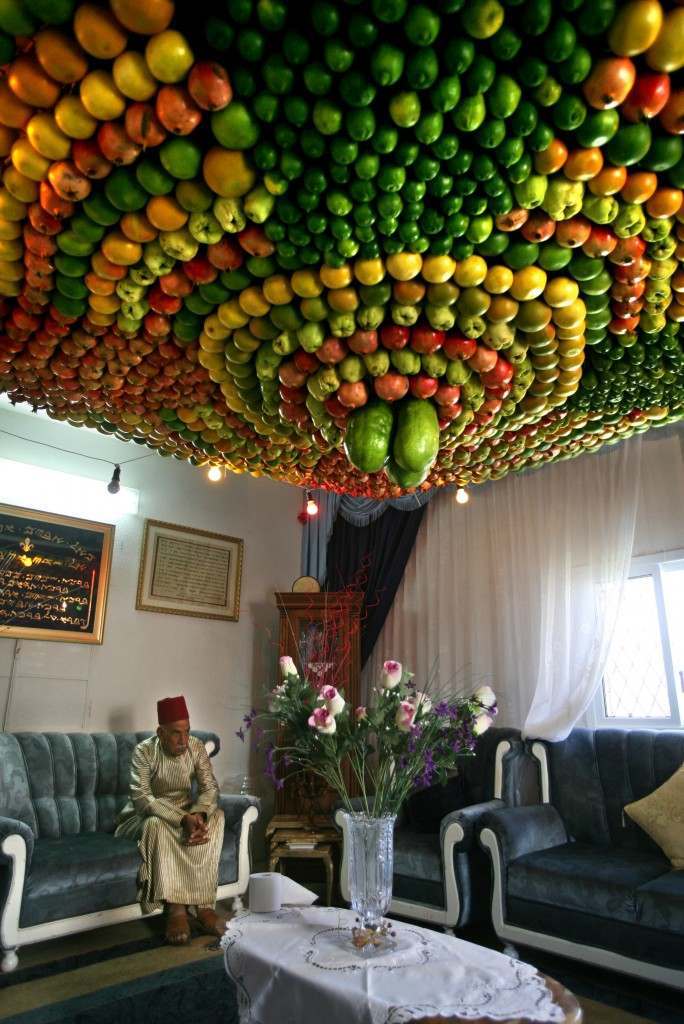
Men from the Cohen family of the ancient Samaritan community sit under a Sukka, made from fresh fruit in celebration of the holy day of the Tabernacles or Sukkot in Mount Gerizim near the West Bank town of Nablus, Friday, Oct. 6, 2006. According to tradition, the Samaritans are descendants of Jews who were not deported when the Assyrians conquered Israel in the 8th century B.C. Of the small community of close to 700 people, half live in a village at Mount Gerizim, and the rest in the city of Holon near Tel Aviv. (AP Photo/Kevin Frayer)
Ref #: PA.4032913
Date: 06/10/2006

Members of the ancient Samaritan community read from their religious books as they pray during the pilgrimage for the holy day of the Tabernacles or Sukkot at the religion’s holiest site on the top of Mount Gerizim near the West Bank town of Nablus, Friday, Oct. 6, 2006. According to tradition, the Samaritans are descendants of Jews who were not deported when the Assyrians conquered Israel in the 8th century B.C. Of the small community of close to 700 people, half live in a village at Mount Gerizim, and the rest in the city of Holon near Tel Aviv. (AP Photo/Kevin Frayer)
Ref #: PA.4032870
Date: 06/10/2006
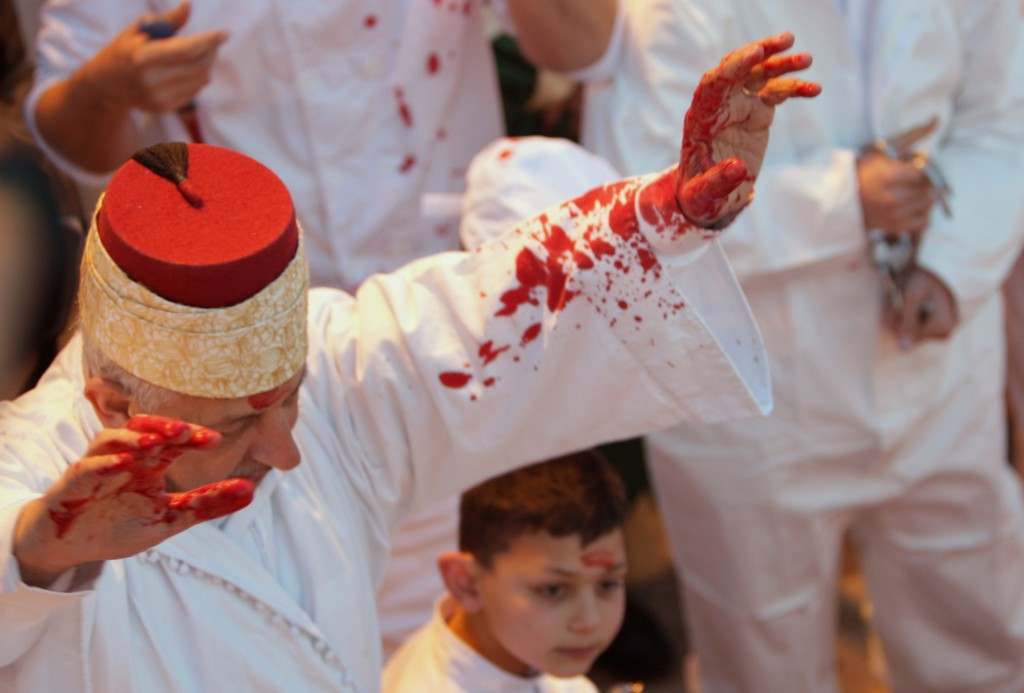
Members of the ancient Samaritan community participate in the ritual of Passover Sacrifice on Mount Grizim, overlooking the West Bank town of Nablus, Sunday, April 13, 2014. Samaritans descended from the ancient Israelite tribes of Menashe and Efraim but broke away from mainstream Judaism 2,800 years ago. Today, the remaining 700 Samaritans live in the Palestinian city of Nablus in the West Bank and the Israeli seaside town of Holon, south of Tel Aviv. (AP Photo/Nasser Ishtayeh)
Ref #: PA.19558986
Date: 13/04/2014
Would you like to support Flashbak?
Please consider making a donation to our site. We don't want to rely on ads to bring you the best of visual culture. You can also support us by signing up to our Mailing List. And you can also follow us on Facebook, Instagram and Twitter. For great art and culture delivered to your door, visit our shop.
